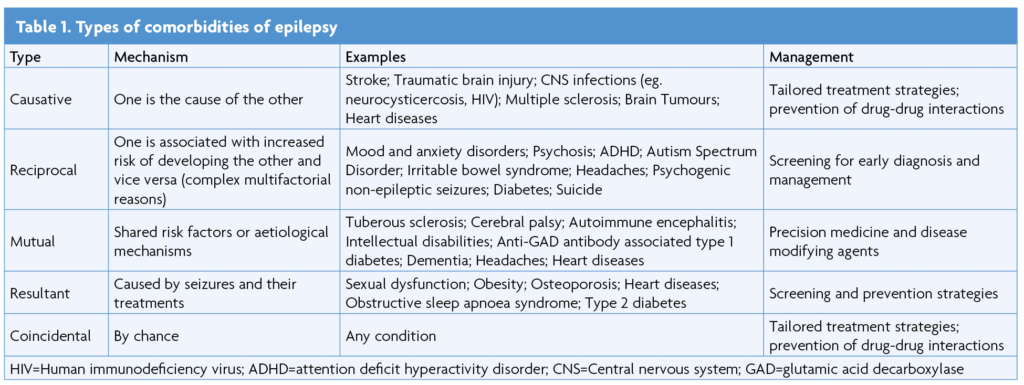Epilepsy is one of the most frequent neurological disorders after stroke and headache, affecting over 70 million people worldwide, and it is now widely accepted that having epilepsy does not simply mean having recurrent seizures. In fact, epilepsy rarely stands alone and more than 50% of patients with epilepsy have one or several additional medical problems [1]. This is reflected in the new multiaxial classification of the epilepsies of the International League Against Epilepsy that includes comorbidities along with seizure types, aetiologies and syndromic classification [2].
The word “comorbidity” dates back to Alvan Feinstein who introduced this term in 1970 referring to any distinct additional clinical entity that existed during the clinical course of a patient’s index disease [3]. However, in the context of epilepsy, the term “comorbidity” includes a heterogenous group of conditions whose pathophysiology can be quite different [4]. Some conditions may coexist simply because one is the cause of the epilepsy like, for example, stroke and epilepsy or neurocisticercosis and epilepsy. In other cases, the condition is the consequence of having epilepsy or its treatment like for example osteoporosis and epilepsy or sexual dysfunction and epilepsy. Still, some conditions may share with epilepsy a common aetiology, like autism and epilepsy in the context of Tuberous Sclerosis Complex, or may be linked by a more complex bidirectional relationship like epilepsy and depression.
Whether these problems are due to shared biological mechanisms, a consequence of having epilepsy or simply due to the unfortunate occurrence of two conditions in the same individual, there is no doubt that the management of these patients can be challenging [4]. This can be due to the potential for drug-drug interactions that Neurologists need to be aware of or because the comorbid disorder has an impact on the epilepsy and its management. In fact, comorbidities do not simply affect quality of life of patients but also represent prognostic markers and affects health costs resulting in increased hospitalisation rates, longer hospital length of stay, frequent health-care visits and, ultimately, higher health-related costs [5].
In order to develop successful therapeutic interventions and prevention strategies, it is important to have a clear understanding of the pathophysiology of comorbidities and the magnitude of the problem. The identification, treatment and prevention of comorbidities should become an integral part of epilepsy care and epilepsy centres should lead on the development of treatment guidelines, prevention policies and structured referral pathways for the management of these conditions that can be easily implemented by Neurologists in everyday clinical practice.
This series of articles will explore some among the most frequent and sometimes challenging comorbidities in epilepsy. Focus will be on current research and clinical management. These articles are authored by distinguished experts in the field. I do hope that these articles will stimulate further interest in this area, leading to constant improvements in the care of our patients.

References
- Keezer MR, Sisodiya SM, Sander JW. Comorbidities of epilepsy: current concepts and future perspectives. Lancet Neurol. 2016;15:106-115. https://doi.org/10.1016/S1474-4422(15)00225-2
- Scheffer IE, Berkovic S, Capovilla G, et al. ILAE Classification of the Epilepsies Position Paper of the ILAE Commission for Classification and Terminology. Epilepsia. 2017;58:512-521. https://doi.org/10.1111/epi.13709
- Feinstein AR. The pre-therapeutic classification of co-morbidity in chronic disease. Journal of Chronic Diseases. 1970;23:455-468.
https://doi.org/10.1016/0021-9681(70)90054-8 - Mula M. The Comorbidities of Epilepsy. London: Academic Press; 2019.
- Patel RS, Elmaadawi A, Mansuri Z, et al. Psychiatric Comorbidities and Outcomes in Epilepsy Patients: An Insight from a Nationwide Inpatient Analysis in the United States. Cureus. 2017;9:e1686. https://doi.org/10.7759/cureus.1686

